So, you’ve invested in SEO and are eagerly waiting to see those desired results. But how long does it actually take to see the impact of your SEO efforts?
In this article, we will delve into the timeline of SEO results and give you a clear understanding of what to expect. Whether you’re a website owner, administrator, or just curious about SEO, this article will provide valuable insights on how long it takes to see results with SEO!
In this guide, we’ll cover:
1 How Long Does It Take for SEO to Start Working?
Google says it takes four months to a year to see results with SEO.
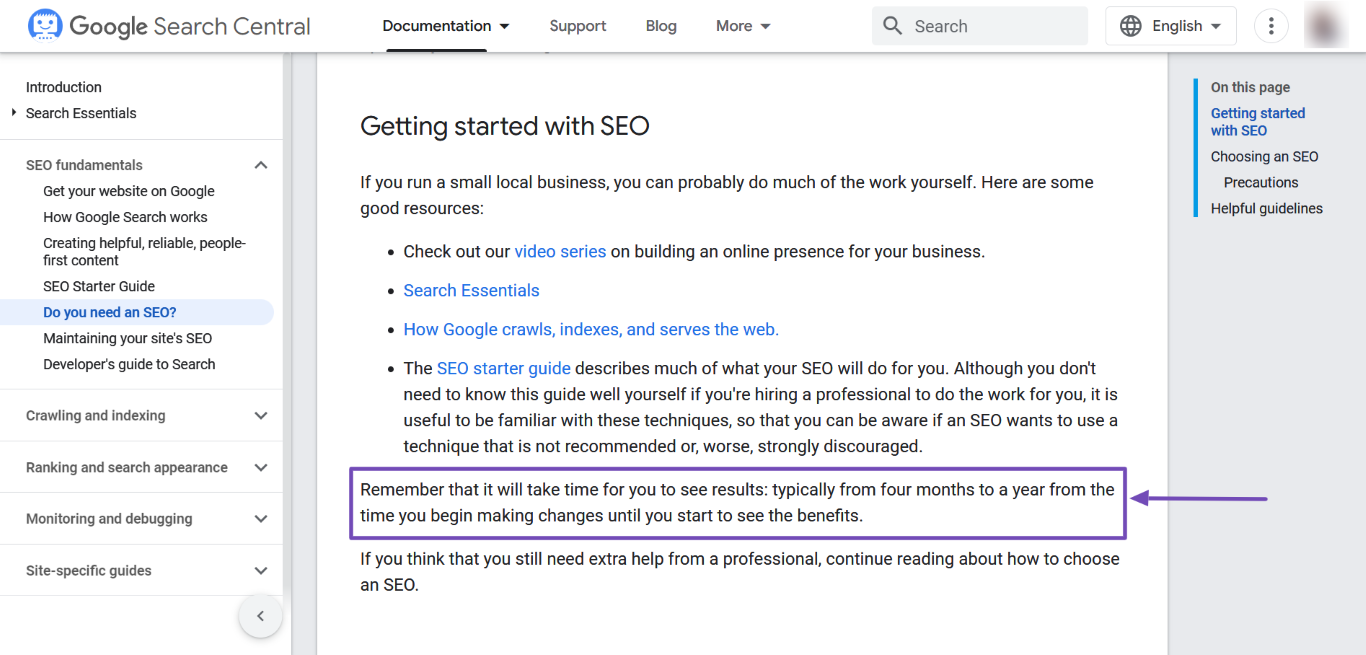
However, seeing results is one thing, and appearing on page one of Google is another. According to a study by Ahrefs, only 5.7% of new web pages get to page one of Google before their first year. The rest take one to three years to get to page one of Google.
2 How Long Will It Take a New Site to See Results With SEO?
While existing sites can see SEO results in a few months, the rules may be different for new sites. To better understand this, we should look at what SEOs have observed and compare it with how Google handles new sites trying to rank in search results.
2.1 The Sandbox Effect
There’s a popular theory that Google uses a filter to prevent new sites from ranking in search results. This filter is called the ‘sandbox effect’ and, according to observers, lasts for between six and nine months. SEOs say that sites placed in the sandbox will never rank, no matter how good their SEO is.

2.2 Google’s Algorithm
John Mueller has clarified that Google doesn’t have a sandbox, though he did mention that Google has some algorithms that may act like the sandbox.
Mueller added that the algorithms try to understand how the new site compares with the other sites ranking for the same keyword. It remains unclear how long these algorithms affect the ranking of a new site, but Matt Cutts has clarified that a new site can rank on Google within a few months.

With that said, it is clear that a new site should expect to encounter some barriers preventing it from ranking within the first few months. This means a new site will take longer to rank than an already established one.
3 How Can I Improve My SEO Rankings?
You can improve your ranking by optimizing your site for the metrics search engines use to determine how your content is displayed in search results. These metrics generally fall into four categories.
3.1 On-Page SEO
On-page SEO refers to the SEO activities that happen on your web pages. For the most part, it involves creating top-quality content that is useful to your user and optimizing it so that search engines know what you’re writing about. Examples of on-page SEO efforts include optimizing headers, adding focus keywords, and table of contents.
Refer to this guide for optimizing your site’s on-page SEO →
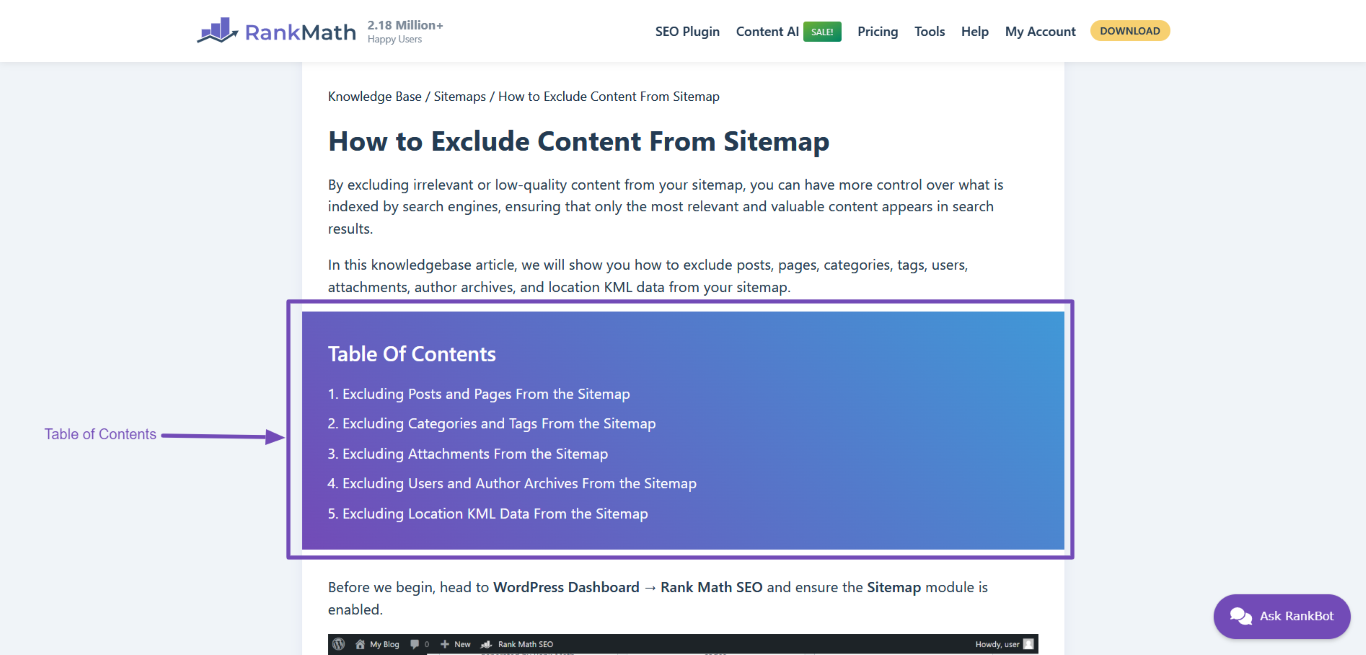
3.2 Technical SEO
Technical SEO refers to the SEO activities that involve your website and server. By server, we’re referring to your hosting provider, domain name registrar, and third-party services like content delivery networks (CDN).
Technical SEO is all about improving your visitor’s user experience and making it easy for search engines to find and crawl your content. Examples of technical SEO include the use of SEO-friendly permalinks, XML sitemaps, and SSL certificates.
While technical SEO can appear overwhelming, it is straightforward if you know what to do.
Refer to this guide for optimizing your site’s technical SEO →
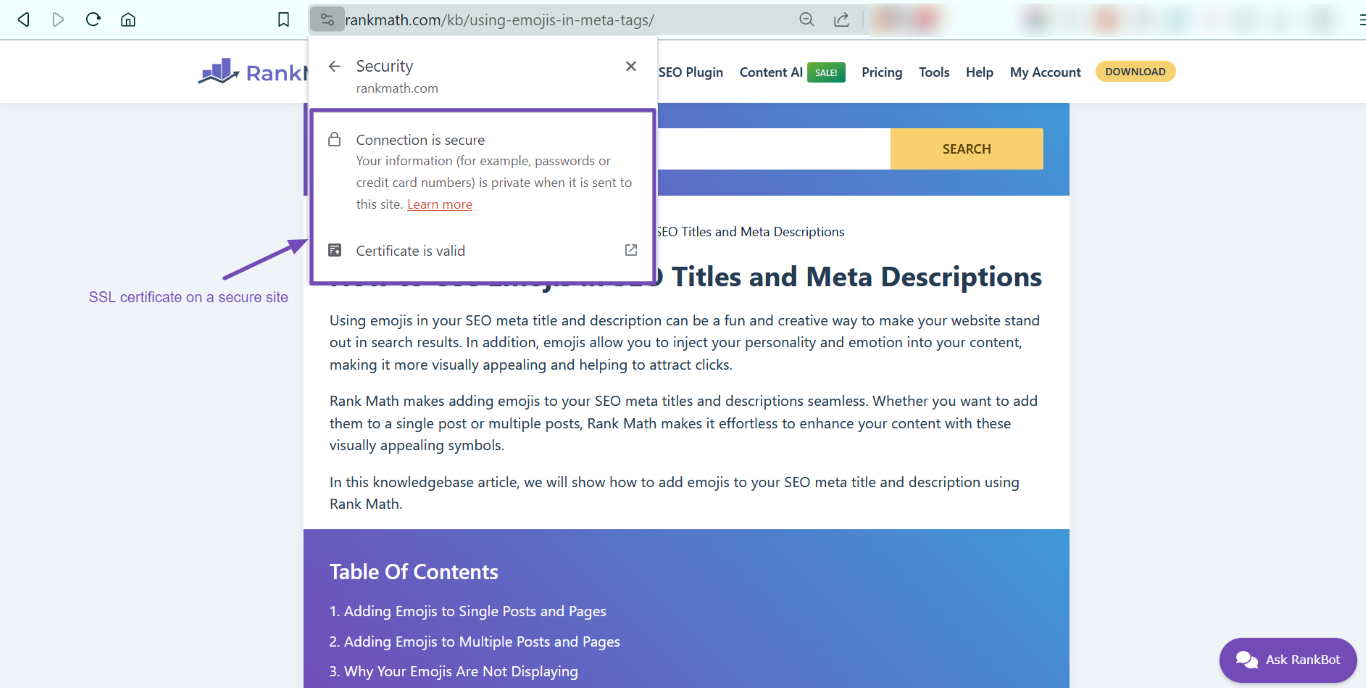
3.3 Off-Page SEO
Off-page SEO refers to the SEO activities that happen off your site. For the most part, off-page SEO involves the backlinks and mentions that you receive from other websites. As you may have guessed, off-page SEO is mainly out of your control, though you could influence it using a series of proven techniques.
Refer to this guide for optimizing your site’s off-page SEO →
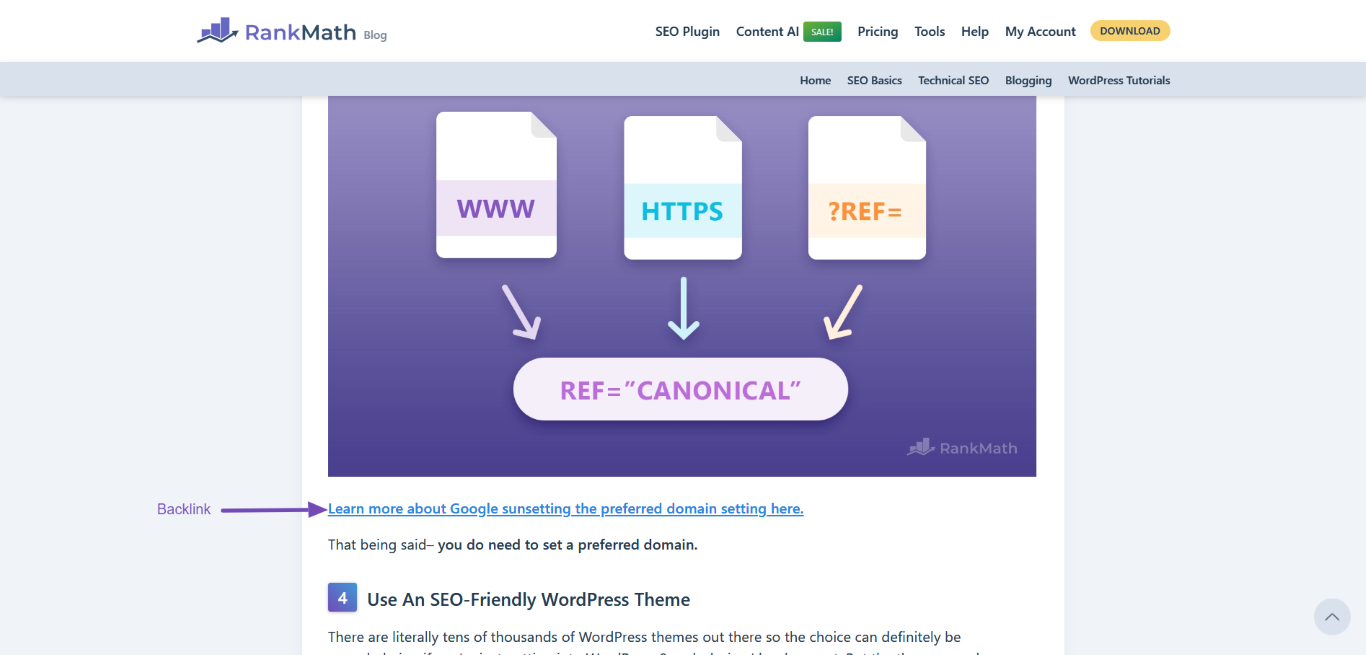
3.4 Local SEO
Local SEO refers to the SEO activities that make your site eligible for display when people search for products and services within a specific location. Local SEO results often display above regular search results, as shown below.
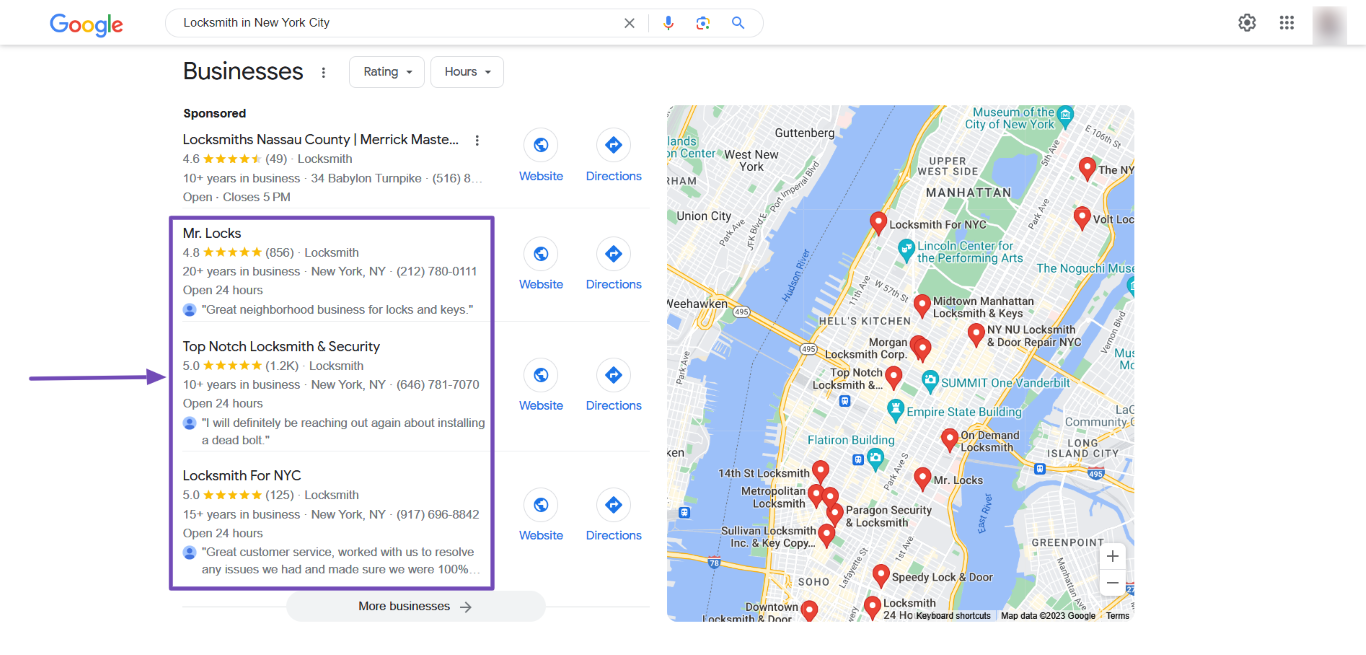
Local SEO is not for everyone. If you have a physical store or offer a service to people within a specific location, then you should get started with local SEO. Thankfully, local SEO is largely within your control.
Refer to this guide to get started with your site’s Local SEO →
4 What Can Affect My Rankings Other Than SEO?
Now, to the big question: If I get my SEO right, will I rank on Google? The answer is ‘maybe.’
The thing is that SEO is a winner-takes-all. There’s only so much space on Google, and the most relevant content for that keyword gets that space for itself. Considering the top-ranking sites usually get their SEO right, Google uses other metrics to determine who gets the top spot.
Note: Some of these metrics have been confirmed by Google, while others are speculations.
4.1 Ads and Popups
According to Google’s Search Quality Raters guidelines, Google will reduce the rankings of pages that contain popups that block the page’s content or ads that push the content lower down the page.
4.2 Domain Registration
In 2003, Google filed a patent detailing its plan to detect spam sites. According to the patent, legitimate sites are likelier to be registered several years in advance. In contrast, spam sites are rarely registered for more than a year.
This means Google may place closer scrutiny on sites registered for a year. In other words, if you want Google to trust your site, then you should register your domain multiple years in advance.
4.3 WHOIS Data
Google may have less trust in sites that keep their WHOIS data private. While many believe Google can access private WHOIS data, Matt Cutts revealed that this is not the case.
With that said, whether you keep your WHOIS data public or private is up to you. Whichever you do, ensure the data is exactly the same as what you have on your Contact page.
4.4 URL Length
Jon Mueller suggests you keep your URL length below 1000 characters. While most sites will never have a URL this long, it is possible to reach this character count if your URL contains autogenerated anchors or parameters.
4.5 Online Reviews
Google once revealed the existence of an algorithm that reduces the rankings of businesses that deliver poor services to their customers. If you sell a product or service, be sure to provide exceptional service and monitor what your customers say about your product on third-party review sites.
4.6 Backlinks
Receiving multiple backlinks from a single source is often an indicator of black hat SEO. This will invite closer scrutiny from Google and may affect your rankings. You can avoid this by keeping the source of your backlinks as diverse as possible.
4.7 YMYL Keywords
Google uses the term, Your Money or Your Life (YMYL) to refer to keywords that may affect a person’s health, safety, or finances. For example, keywords that inform people of what to do in the event of a heart attack, natural disaster, or financial crisis.
Google pays close attention to the sites that can rank for these keywords. Unless you have a reputation in these sectors, it may be hard or even impossible to rank for these keywords.
4.8 IP Address
Google has clarified that it won’t penalize a site because some other site on the same IP address was spamming. However, if there are many spammy sites on a shared IP, then the clean sites on that IP may attract closer scrutiny.
4.9 Competition
While high-volume keywords are traditionally difficult to rank for, a low-volume keyword can become challenging when multiple SEOs try to rank for it. So, even if you get your SEO right, you may find it harder to rank if the sites you are trying to outrank are at the top of their game.
5 How Do You Know if SEO is Working?
As the famous saying goes, ‘What is not measured, cannot be improved.’ If you want to know if your SEO is working, then it is essential that you use Rank Math Analytics to monitor how your content is performing in search.
To get started with Rank Math Analytics, navigate to WordPress Dashboard → Rank Math SEO and enable the Analytics module, as shown below.
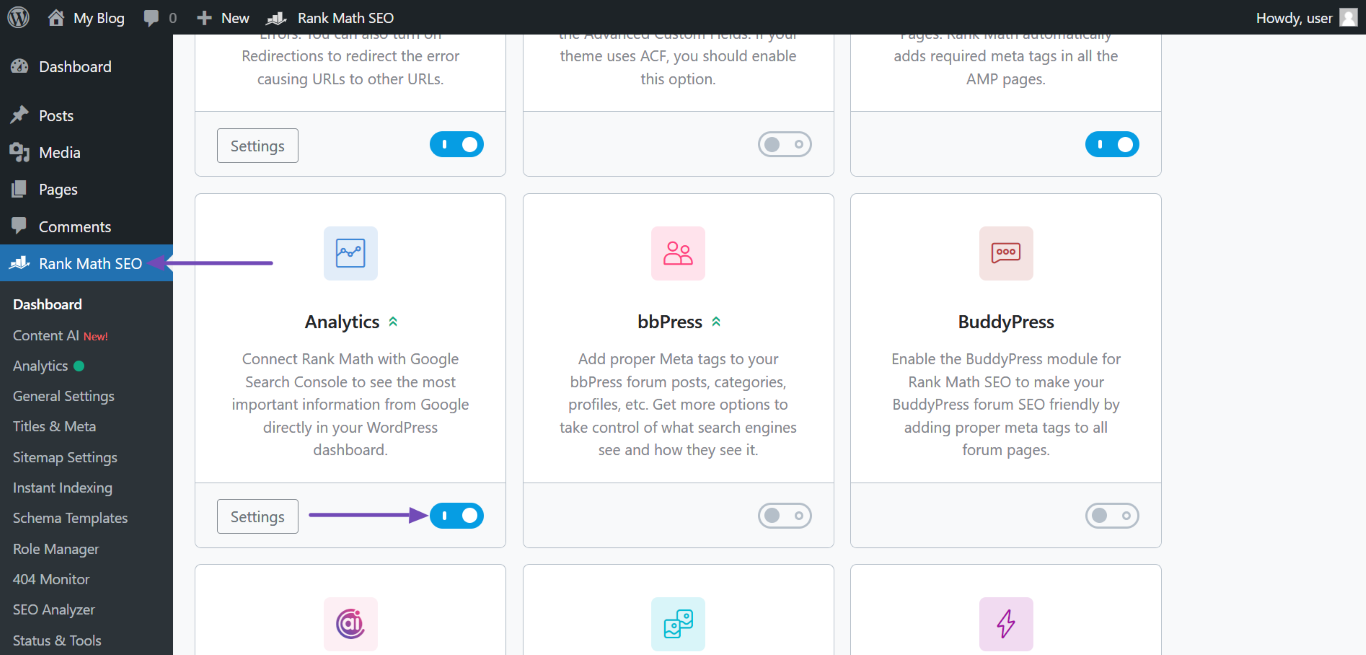
Once done, head to Rank Math SEO → Analytics. You will be presented with your Analytics dashboard, as shown below.
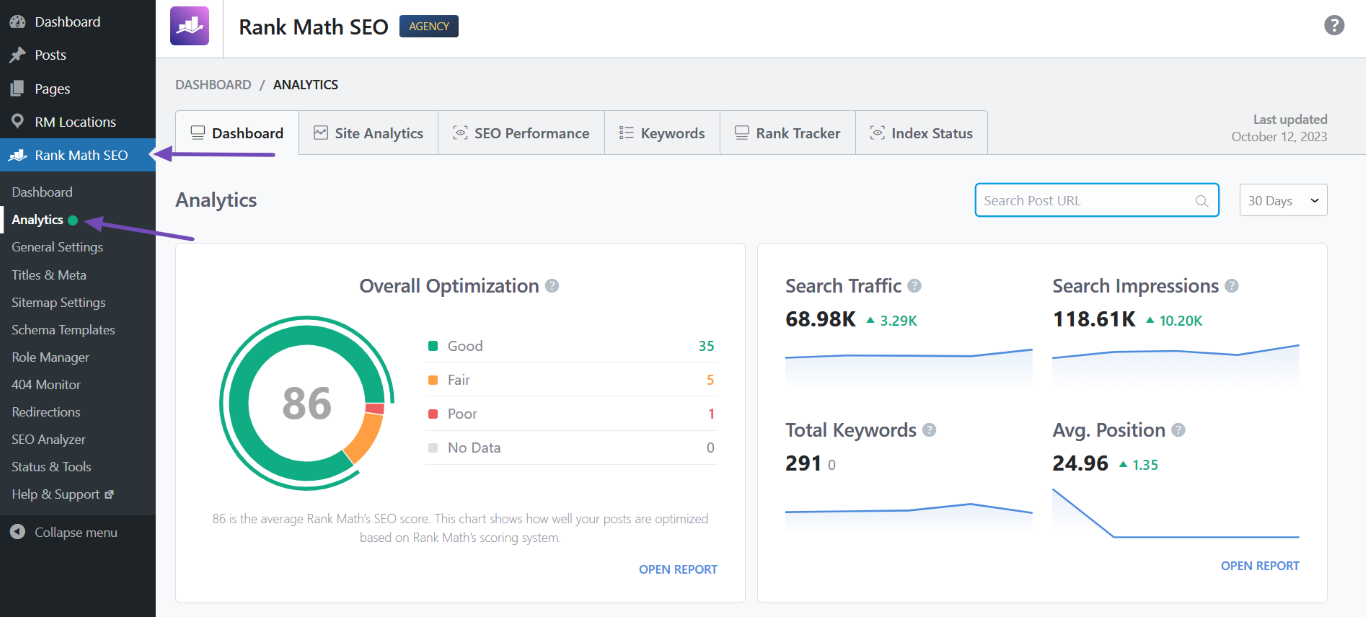
The Rank Math Analytics dashboard gives you valuable insights into your content. From the dashboard, you get an overview of:
- The number of times your site appeared in search.
- The number of times visitors clicked on your site from search.
- The number of keywords not in the top 100 results on Google.
- The average position of the keywords that are not in the top 100 results on Google.
- Your best-performing keywords.
- Your worst-performing keywords.
- Your best-performing posts.
- Your worst-performing posts.
You can click the tabs at the top of the Analytics page for detailed insights.
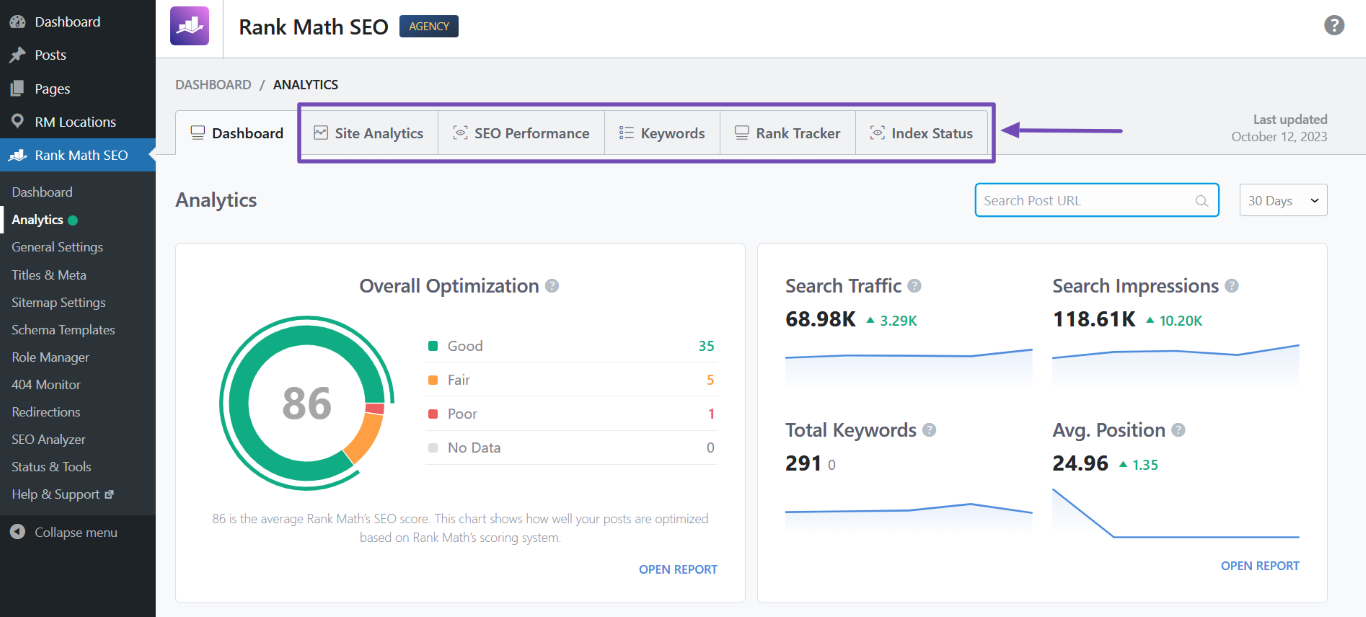
Below, we will briefly explain the available tabs and the data they display.
5.1 Site Analytics PRO
Anyone who has spent time in SEO knows that 20% of the content accounts for 80% of the traffic. The SEO Analytics tab lets you identify the content bringing in the most traffic. That way, you can determine your top-performing content and know where to direct your SEO efforts.
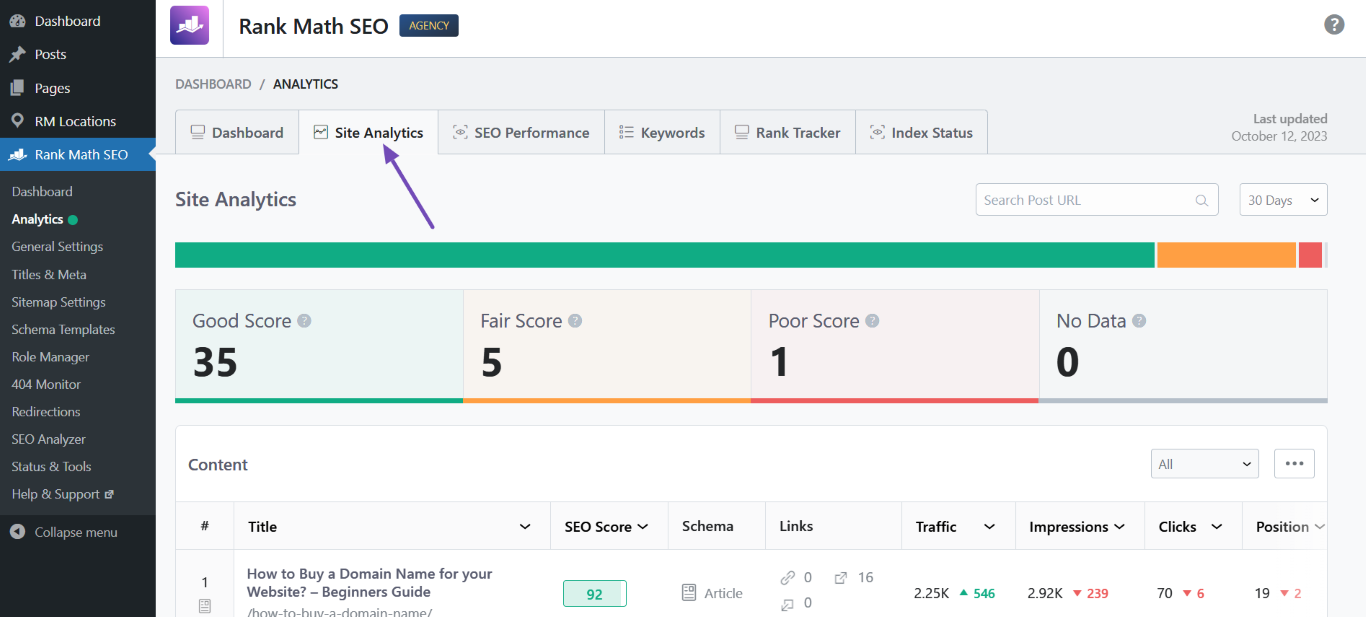
5.2 SEO Performance
The SEO Performance tab allows you to monitor the performance of your content. From this tab, you can uncover the impressions, clicks, and traffic you got from search, along with the keywords you’re ranking for, your clickthrough rate, and your average position in search results.
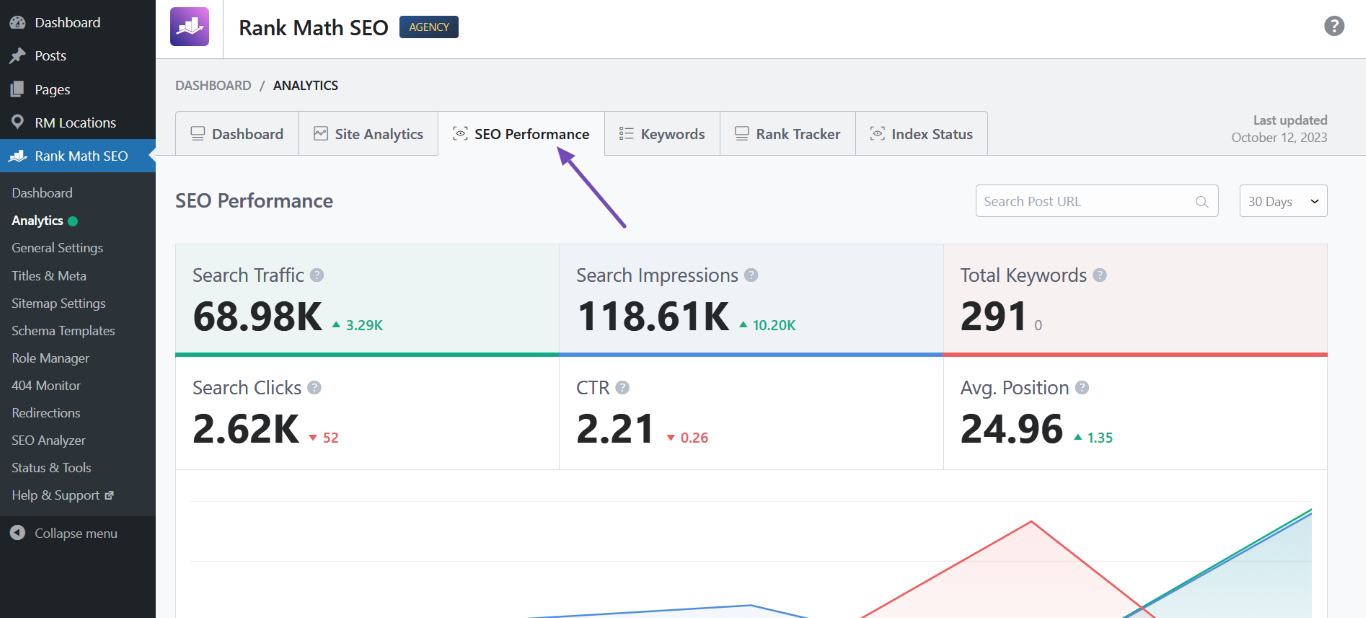
5.3 Keywords
The Keywords tab allows you to monitor the position of your site in search results. By observing whether you’re gaining or losing rankings, you can quickly identify potential problems or opportunities and optimize your content so you get the most results.
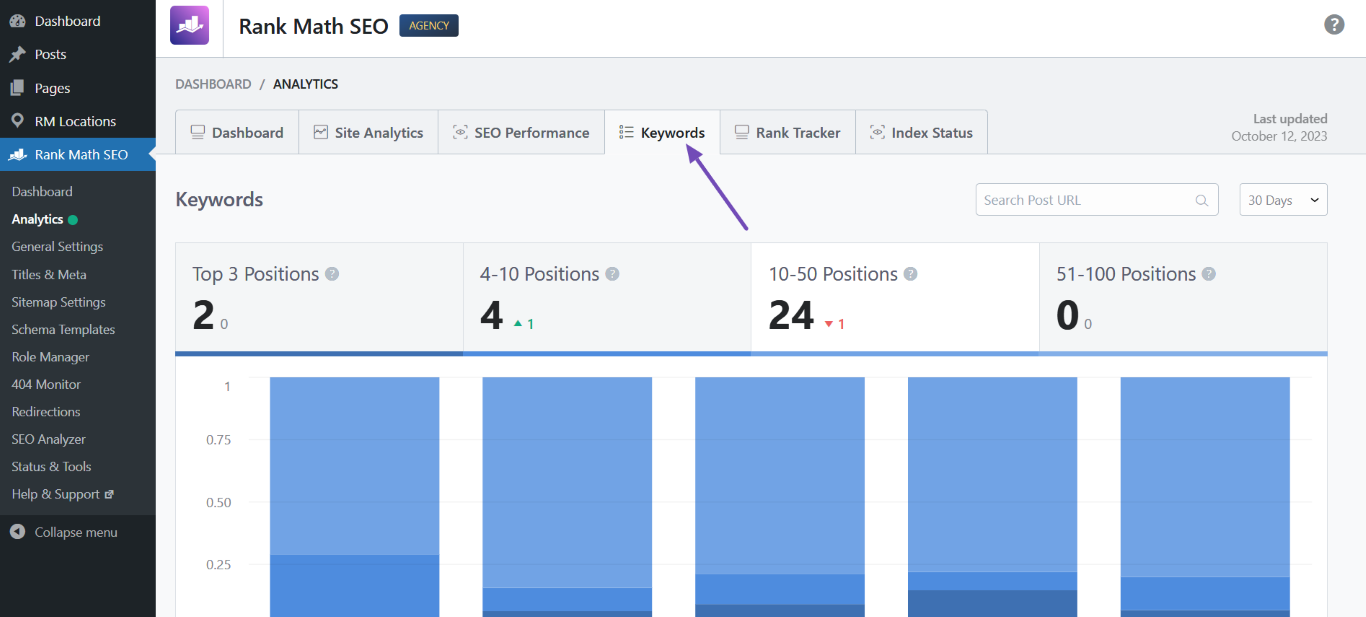
5.4 Rank Tracker PRO
The Rank Tracker allows you to monitor the performance of keywords that interest you. It provides you with the winning and losing keywords so you know which keywords to include in your content and which ones to ignore.
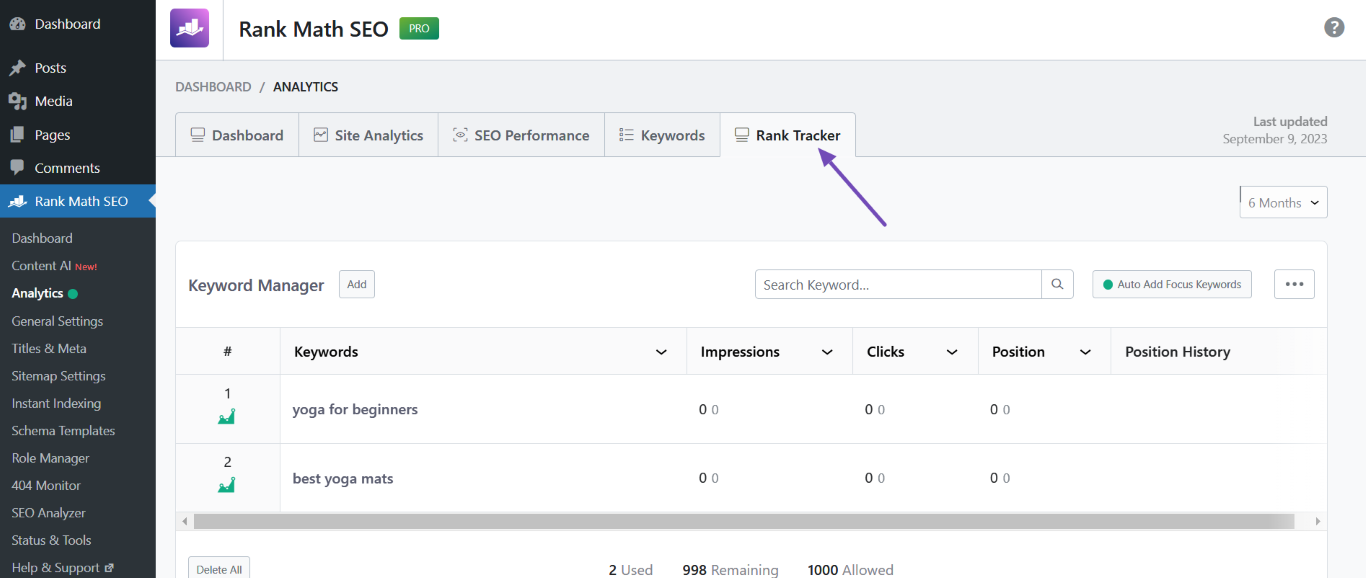
This was just a sneak peek of the tabs in Rank Math Analytics. The tabs contain detailed reports that allow you to see how well your content is optimized for SEO and monitor their performance in search. You can refer to this detailed guide to getting started with Rank Math Analytics.
In conclusion, the timeframe for seeing results with SEO varies depending on the circumstances. Established websites can expect to see improvements within four months, while new sites may need to exercise more patience.
However, as you improve your SEO, you should monitor your rankings to ensure your improvements work as expected. If you have any questions, you’re more than welcome to contact our dedicated support team. We’re available 24/7, 365 days a year…